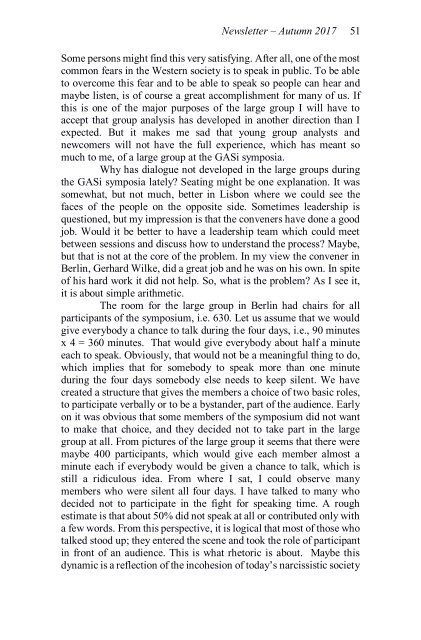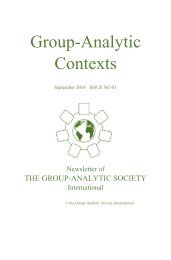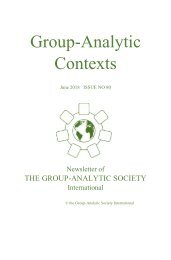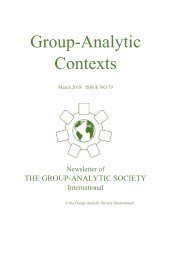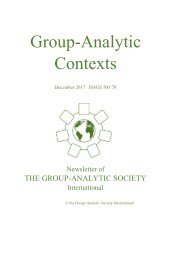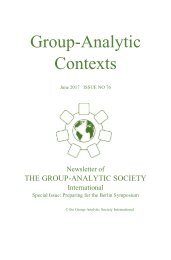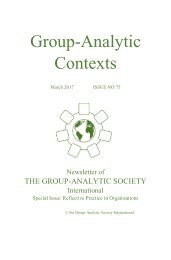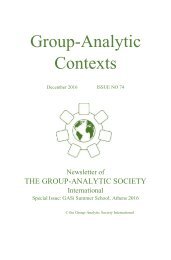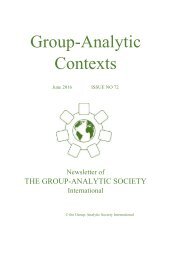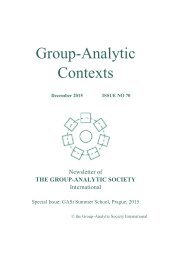Group Analytic Contexts, Issue 77, September 2017
Newsletter of the Group Analytic Society International
Newsletter of the Group Analytic Society International
Create successful ePaper yourself
Turn your PDF publications into a flip-book with our unique Google optimized e-Paper software.
Newsletter – Autumn <strong>2017</strong> 51<br />
Some persons might find this very satisfying. After all, one of the most<br />
common fears in the Western society is to speak in public. To be able<br />
to overcome this fear and to be able to speak so people can hear and<br />
maybe listen, is of course a great accomplishment for many of us. If<br />
this is one of the major purposes of the large group I will have to<br />
accept that group analysis has developed in another direction than I<br />
expected. But it makes me sad that young group analysts and<br />
newcomers will not have the full experience, which has meant so<br />
much to me, of a large group at the GASi symposia.<br />
Why has dialogue not developed in the large groups during<br />
the GASi symposia lately? Seating might be one explanation. It was<br />
somewhat, but not much, better in Lisbon where we could see the<br />
faces of the people on the opposite side. Sometimes leadership is<br />
questioned, but my impression is that the conveners have done a good<br />
job. Would it be better to have a leadership team which could meet<br />
between sessions and discuss how to understand the process? Maybe,<br />
but that is not at the core of the problem. In my view the convener in<br />
Berlin, Gerhard Wilke, did a great job and he was on his own. In spite<br />
of his hard work it did not help. So, what is the problem? As I see it,<br />
it is about simple arithmetic.<br />
The room for the large group in Berlin had chairs for all<br />
participants of the symposium, i.e. 630. Let us assume that we would<br />
give everybody a chance to talk during the four days, i.e., 90 minutes<br />
x 4 = 360 minutes. That would give everybody about half a minute<br />
each to speak. Obviously, that would not be a meaningful thing to do,<br />
which implies that for somebody to speak more than one minute<br />
during the four days somebody else needs to keep silent. We have<br />
created a structure that gives the members a choice of two basic roles,<br />
to participate verbally or to be a bystander, part of the audience. Early<br />
on it was obvious that some members of the symposium did not want<br />
to make that choice, and they decided not to take part in the large<br />
group at all. From pictures of the large group it seems that there were<br />
maybe 400 participants, which would give each member almost a<br />
minute each if everybody would be given a chance to talk, which is<br />
still a ridiculous idea. From where I sat, I could observe many<br />
members who were silent all four days. I have talked to many who<br />
decided not to participate in the fight for speaking time. A rough<br />
estimate is that about 50% did not speak at all or contributed only with<br />
a few words. From this perspective, it is logical that most of those who<br />
talked stood up; they entered the scene and took the role of participant<br />
in front of an audience. This is what rhetoric is about. Maybe this<br />
dynamic is a reflection of the incohesion of today’s narcissistic society


